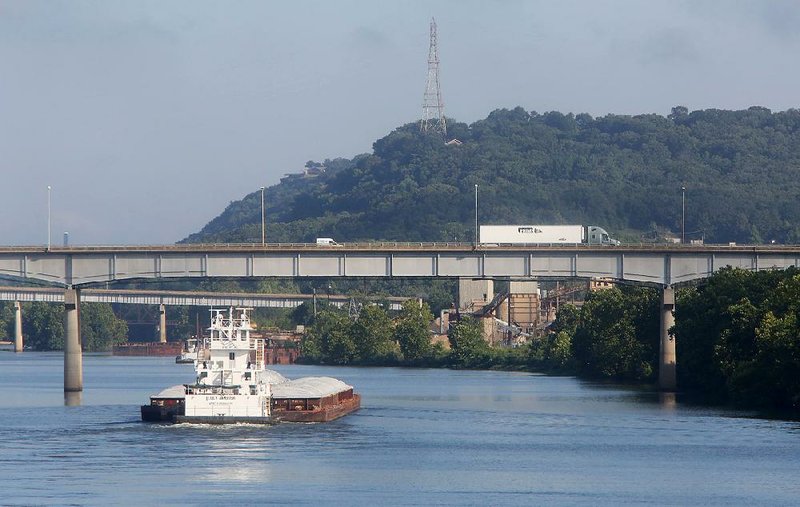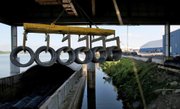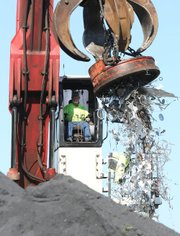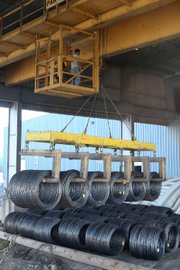Almost 12 million tons of commodities trickle through the Arkansas River each year -- a figure that likely will grow as trade officials announced earlier this month they have finalized a protocol to allow for the first-ever shipments of U.S.-grown rice to China.
Census data show about $223 million worth of rice left the state in 2016. Overall agricultural exports produced about $3.7 billion for the state's economy. But moving agricultural exports by water is challenging as much of the infrastructure is outdated.
Most locks and dams along the state's waterways are about 50 years old. Preventive maintenance has turned into critical repairs. A list of maintenance needs drawn up by the U.S. Army Corps of Engineers in 2016 included 16 "critical" situations along the McClellan-Kerr river system, which accounts for the Arkansas River.
The Corps is waiting on Congress to approve a new budget and for President Donald Trump to announce his U.S. infrastructure revitalization plan.
Gil Wootten, technical support chief of operations for the Corps in Little Rock, oversees maintenance units in Arkansas' portion of the Arkansas River.
"I think from what we've seen over the years, our infrastructure is aging, so our backlog [of fixes has] in the past 10 years doubled," he said.
In the meantime, the state of Arkansas is not stopping. Workers along the river start about 7 a.m. daily to unload and reload barge-fulls of wire and grains, and swing cranes of scrap metal into tractor-trailers. Some workers can be found putting in time on Saturdays to make up for delayed shipments which were caused by spring flooding.
To keep shipping at a steady pace, the Corps keeps in close contact with logistics companies. Announcements of forthcoming repairs are dispersed months -- and sometimes years -- ahead of time.
When this happens, logisticians must adapt, either by loading more cargo onto trucks, or packing down barges more heavily than normal. Repairs are increasingly urgent because more businesses are looking at Arkansas as a place to make money. New business means more trading, which translates to more work -- and potentially a growth in activity along the rivers, state officials hope.
When Gov. Asa Hutchinson took office in 2015, the state began courting foreign companies. Today, there are about 240 foreign-based companies operating here, according to a report prepared by the state.
Mike Preston, executive director of the Arkansas Economic Development Commission, said the state's waterways are vital to keeping those companies here. He said the commission markets Arkansas' transportation capacity when selling the state to executives abroad.
"But if they can't get that product out of the state, they have no reason to be here," Preston said.
Because of the magnitude of global trading, movements along supply chains are planned months and years in advance, so last-minute hiccups at a lock in Arkansas can cause shortages somewhere else in the world.
"Nothing is decided today and moved tomorrow," said J.O. Norman, operations manager of grain and barges at Bruce Oakley in Little Rock.
His company owns about 228 barges that run in ports and rivers throughout the country. What sets Arkansas apart from many other states is its river locks do not have auxiliary chambers. The chambers are used during maintenance to allow vessels to continue onward, albeit at a smaller volume and pace. In Arkansas, when a lock needs to be fixed, traffic stops.
The U.S. barge and tug boat industry moves about 763 million tons of cargo on average each year, according to a new report by the American Waterways Operators. In 2014, the year of analysis in the study, the industry drove about $19.4 billion in economic activity domestically. More barges travel through the middle part of the country than the Great Lakes or West and East coast ports combined.
Some tow and tug companies have turned away from some of Arkansas' rivers. In 2012, the Corps began studying the nation's waterways in its Inland Marine Transport System report. Because of budget cuts from Washington, the Corps used the results to determine, among other objectives, which locks and dams were priorities to keep at full capacity.
According to lock volume data on the Ouachita River, commercial vessel traffic through the Thatcher and Felsenthal locks has dwindled to nothing since 2012. Deidre Smith, the new head of the Arkansas Waterways Commission, said the Red River in Arkansas is not navigable, and commercial traffic through the White River is next to nothing. A spokesman for the Corps said the larger rivers with higher volumes are the priority.
Rayford Willbanks of Vicksburg, Miss., is retired from the Corps. Since October he has been the executive director of the Ouachita River Valley Association.
"When you don't have the full service at those locks and dams, and you don't have the budgeting for dredging to make sure waterways are open and safe, the industries will shy away," Willbanks said.
He noted at least three tug companies left the Ouachita River. Of those, only Kilgore, Texas-based Martin Midstream Partners returned calls seeking comment. Doug Towns, vice president of the company's cross-well segment, said his company's move from the Ouachita had more to do with a preference for pipeline transportation, but he said they knew the Corps would stop maintaining the river to a 9-foot depth, the safety standard for navigation.
"It either had too much water or not enough," he said.
The Corps' 2018 budget proposal to Congress includes about $10 million for various projects around Arkansas. There is, however, a gap in what Congress approves and what it funds. For example, lawmakers have already approved the Arkansas River to be dug at a 12-foot depth, which would allow shippers to pack more cargo onto barges, but there has not been any money allocated for such a project, said Laurie Driver, a Corps spokesman.
"Our funding is very strict and stringent," she said.
Many of the dams' "tainter" gates need to be replaced. Those are the walls that rise and let water through when a vessel is moving through a lock. Wootten and Corps crews are discovering more problems that might not get funding for two more years, the length of the federal budget cycle. New problems will likely surface in between funding periods.
For Marty Shell, the owner of Five Rivers Distribution in Van Buren, the work is personal. His father started the company decades ago, and today the pressure is on his workers to keep pace with companies around the world. Five Rivers has an intermodal port facility on the Arkansas River.
"They're going to work harder," he said, "and they're going to work longer."
SundayMonday Business on 07/30/2017




